Gang Yang
Compose Yourself: Average-Velocity Flow Matching for One-Step Speech Enhancement
Sep 19, 2025Abstract:Diffusion and flow matching (FM) models have achieved remarkable progress in speech enhancement (SE), yet their dependence on multi-step generation is computationally expensive and vulnerable to discretization errors. Recent advances in one-step generative modeling, particularly MeanFlow, provide a promising alternative by reformulating dynamics through average velocity fields. In this work, we present COSE, a one-step FM framework tailored for SE. To address the high training overhead of Jacobian-vector product (JVP) computations in MeanFlow, we introduce a velocity composition identity to compute average velocity efficiently, eliminating expensive computation while preserving theoretical consistency and achieving competitive enhancement quality. Extensive experiments on standard benchmarks show that COSE delivers up to 5x faster sampling and reduces training cost by 40%, all without compromising speech quality. Code is available at https://github.com/ICDM-UESTC/COSE.
Hybrid-Tower: Fine-grained Pseudo-query Interaction and Generation for Text-to-Video Retrieval
Sep 05, 2025Abstract:The Text-to-Video Retrieval (T2VR) task aims to retrieve unlabeled videos by textual queries with the same semantic meanings. Recent CLIP-based approaches have explored two frameworks: Two-Tower versus Single-Tower framework, yet the former suffers from low effectiveness, while the latter suffers from low efficiency. In this study, we explore a new Hybrid-Tower framework that can hybridize the advantages of the Two-Tower and Single-Tower framework, achieving high effectiveness and efficiency simultaneously. We propose a novel hybrid method, Fine-grained Pseudo-query Interaction and Generation for T2VR, ie, PIG, which includes a new pseudo-query generator designed to generate a pseudo-query for each video. This enables the video feature and the textual features of pseudo-query to interact in a fine-grained manner, similar to the Single-Tower approaches to hold high effectiveness, even before the real textual query is received. Simultaneously, our method introduces no additional storage or computational overhead compared to the Two-Tower framework during the inference stage, thus maintaining high efficiency. Extensive experiments on five commonly used text-video retrieval benchmarks demonstrate that our method achieves a significant improvement over the baseline, with an increase of $1.6\% \sim 3.9\%$ in R@1. Furthermore, our method matches the efficiency of Two-Tower models while achieving near state-of-the-art performance, highlighting the advantages of the Hybrid-Tower framework.
YUNet: Improved YOLOv11 Network for Skyline Detection
Feb 18, 2025Abstract:Skyline detection plays an important role in geolocalizaion, flight control, visual navigation, port security, etc. The appearance of the sky and non-sky areas are variable, because of different weather or illumination environment, which brings challenges to skyline detection. In this research, we proposed the YUNet algorithm, which improved the YOLOv11 architecture to segment the sky region and extract the skyline in complicated and variable circumstances. To improve the ability of multi-scale and large range contextual feature fusion, the YOLOv11 architecture is extended as an UNet-like architecture, consisting of an encoder, neck and decoder submodule. The encoder extracts the multi-scale features from the given images. The neck makes fusion of these multi-scale features. The decoder applies the fused features to complete the prediction rebuilding. To validate the proposed approach, the YUNet was tested on Skyfinder and CH1 datasets for segmentation and skyline detection respectively. Our test shows that the IoU of YUnet segmentation can reach 0.9858, and the average error of YUnet skyline detection is just 1.36 pixels. The implementation is published at https://github.com/kuazhangxiaoai/SkylineDet-YOLOv11Seg.git.
Advancing Single- and Multi-task Text Classification through Large Language Model Fine-tuning
Dec 11, 2024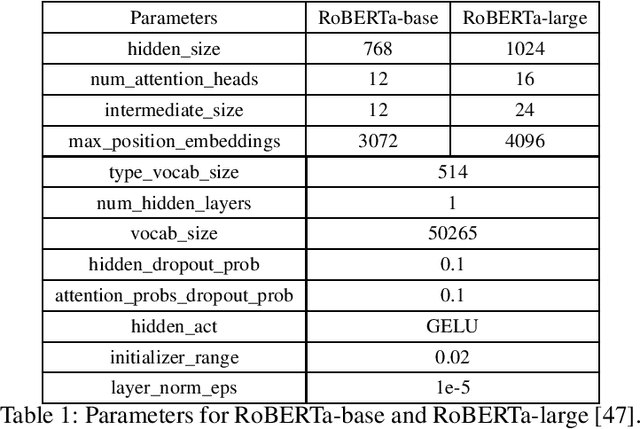
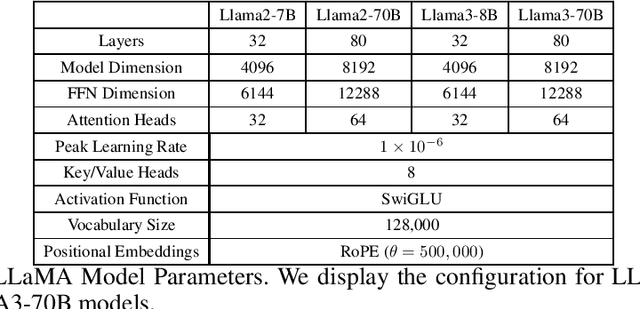
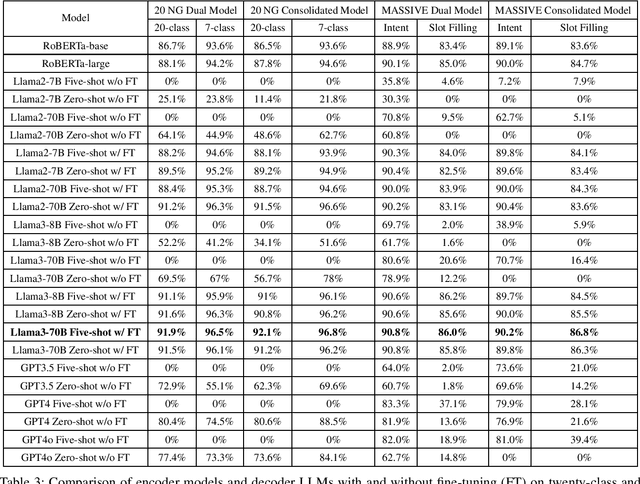
Abstract:Both encoder-only models (e.g., BERT, RoBERTa) and large language models (LLMs, e.g., Llama3) have been widely used for text classification tasks. However, there is a lack of systematic studies comparing the performance of encoder-based models and LLMs in text classification, particularly when fine-tuning is involved. This study employed a diverse range of models and methods, varying in size and architecture, and including both fine-tuned and pre-trained approaches. We first assessed the performances of these LLMs on the 20 Newsgroups (20NG) and MASSIVE datasets, comparing them to encoder-only RoBERTa models. Additionally, we explored the multi-task capabilities of both model types by combining multiple classification tasks, including intent detection and slot-filling, into a single model using data from both datasets. Our results indicate that fully fine-tuned Llama3-70B models outperform RoBERTa-large and other decoder LLMs across various classification tasks and datasets. Moreover, the consolidated multi-task fine-tuned LLMs matched the performance of dual-model setups in both tasks across both datasets. Overall, our study provides a comprehensive benchmark of encoder-only and LLM models on text classification tasks and demonstrates a method to combine two or more fully fine-tuned decoder LLMs for reduced latency and equivalent performance.
Stable Object Placement Under Geometric Uncertainty via Differentiable Contact Dynamics
Sep 26, 2024Abstract:From serving a cup of coffee to carefully rearranging delicate items, stable object placement is a crucial skill for future robots. This skill is challenging due to the required accuracy, which is difficult to achieve under geometric uncertainty. We leverage differentiable contact dynamics to develop a principled method for stable object placement under geometric uncertainty. We estimate the geometric uncertainty by minimizing the discrepancy between the force-torque sensor readings and the model predictions through gradient descent. We further keep track of a belief over multiple possible geometric parameters to mitigate the gradient-based method's sensitivity to the initialization. We verify our approach in the real world on various geometric uncertainties, including the in-hand pose uncertainty of the grasped object, the object's shape uncertainty, and the environment's shape uncertainty.
Low-Complexity Joint Azimuth-Range-Velocity Estimation for Integrated Sensing and Communication with OFDM Waveform
May 15, 2024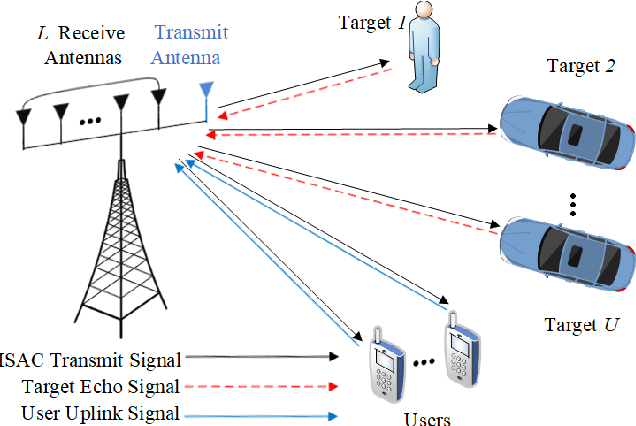
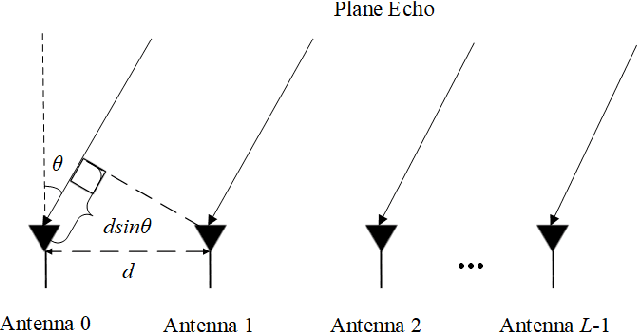
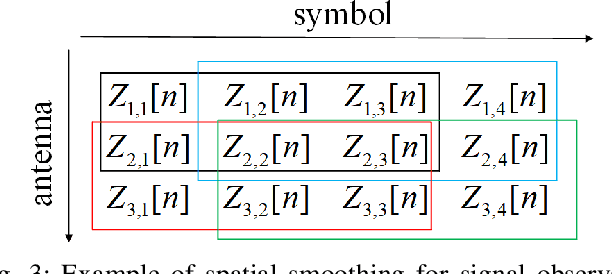
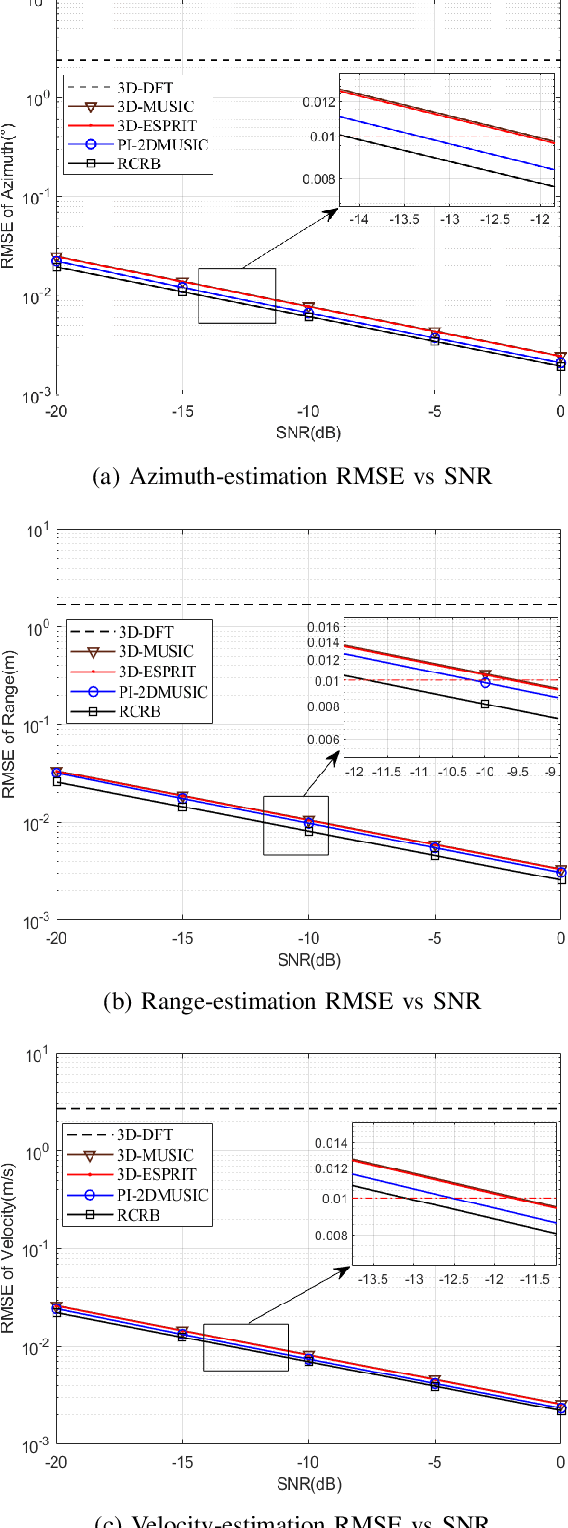
Abstract:Integrated sensing and communication (ISAC) is a main application scenario of the sixth-generation mobile communication systems. Due to the fast-growing number of antennas and subcarriers in cellular systems, the computational complexity of joint azimuth-range-velocity estimation (JARVE) in ISAC systems is extremely high. This paper studies the JARVE problem for a monostatic ISAC system with orthogonal frequency division multiplexing (OFDM) waveform, in which a base station receives the echos of its transmitted cellular OFDM signals to sense multiple targets. The Cramer-Rao bounds are first derived for JARVE. A low-complexity algorithm is further designed for super-resolution JARVE, which utilizes the proposed iterative subspace update scheme and Levenberg-Marquardt optimization method to replace the exhaustive search of spatial spectrum in multiple-signal-classification (MUSIC) algorithm. Finally, with the practical parameters of 5G New Radio, simulation results verify that the proposed algorithm can reduce the computational complexity by three orders of magnitude and two orders of magnitude compared to the existing three-dimensional MUSIC algorithm and estimation-of-signal-parameters-using-rotational-invariance-techniques (ESPRIT) algorithm, respectively, and also improve the estimation performance.
ManiFoundation Model for General-Purpose Robotic Manipulation of Contact Synthesis with Arbitrary Objects and Robots
May 11, 2024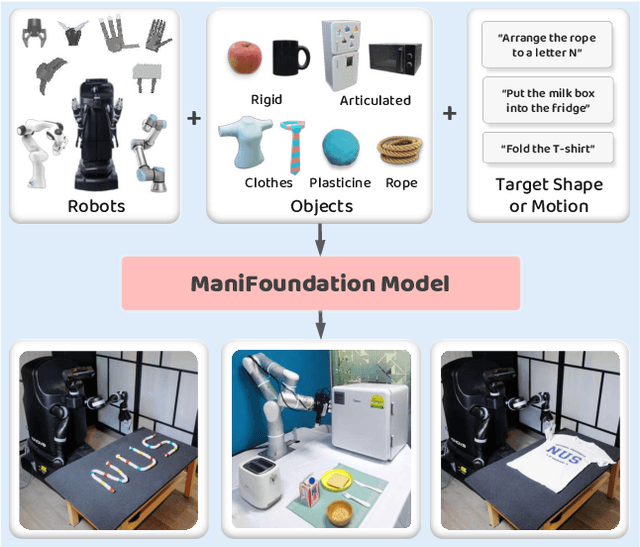
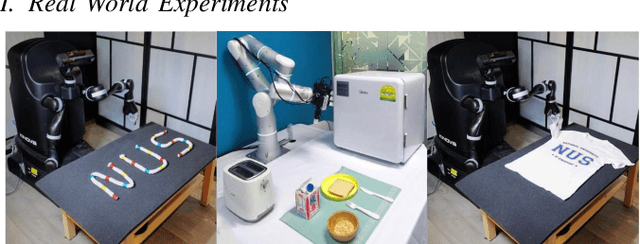


Abstract:To substantially enhance robot intelligence, there is a pressing need to develop a large model that enables general-purpose robots to proficiently undertake a broad spectrum of manipulation tasks, akin to the versatile task-planning ability exhibited by LLMs. The vast diversity in objects, robots, and manipulation tasks presents huge challenges. Our work introduces a comprehensive framework to develop a foundation model for general robotic manipulation that formalizes a manipulation task as contact synthesis. Specifically, our model takes as input object and robot manipulator point clouds, object physical attributes, target motions, and manipulation region masks. It outputs contact points on the object and associated contact forces or post-contact motions for robots to achieve the desired manipulation task. We perform extensive experiments both in the simulation and real-world settings, manipulating articulated rigid objects, rigid objects, and deformable objects that vary in dimensionality, ranging from one-dimensional objects like ropes to two-dimensional objects like cloth and extending to three-dimensional objects such as plasticine. Our model achieves average success rates of around 90\%. Supplementary materials and videos are available on our project website at https://manifoundationmodel.github.io/.
Dual Graph Attention based Disentanglement Multiple Instance Learning for Brain Age Estimation
Mar 02, 2024



Abstract:Deep learning techniques have demonstrated great potential for accurately estimating brain age by analyzing Magnetic Resonance Imaging (MRI) data from healthy individuals. However, current methods for brain age estimation often directly utilize whole input images, overlooking two important considerations: 1) the heterogeneous nature of brain aging, where different brain regions may degenerate at different rates, and 2) the existence of age-independent redundancies in brain structure. To overcome these limitations, we propose a Dual Graph Attention based Disentanglement Multi-instance Learning (DGA-DMIL) framework for improving brain age estimation. Specifically, the 3D MRI data, treated as a bag of instances, is fed into a 2D convolutional neural network backbone, to capture the unique aging patterns in MRI. A dual graph attention aggregator is then proposed to learn the backbone features by exploiting the intra- and inter-instance relationships. Furthermore, a disentanglement branch is introduced to separate age-related features from age-independent structural representations to ameliorate the interference of redundant information on age prediction. To verify the effectiveness of the proposed framework, we evaluate it on two datasets, UK Biobank and ADNI, containing a total of 35,388 healthy individuals. Our proposed model demonstrates exceptional accuracy in estimating brain age, achieving a remarkable mean absolute error of 2.12 years in the UK Biobank. The results establish our approach as state-of-the-art compared to other competing brain age estimation models. In addition, the instance contribution scores identify the varied importance of brain areas for aging prediction, which provides deeper insights into the understanding of brain aging.
RIS Empowered Near-Field Covert Communications
Jan 24, 2024



Abstract:This paper studies an extremely large-scale reconfigurable intelligent surface (XL-RIS) empowered covert communication system in the near-field region. Alice covertly transmits messages to Bob with the assistance of the XL-RIS, while evading detection by Willie. To enhance the covert communication performance, we maximize the achievable covert rate by jointly optimizing the hybrid analog and digital beamformers at Alice, as well as the reflection coefficient matrix at the XL-RIS. An alternating optimization algorithm is proposed to solve the joint beamforming design problem. For the hybrid beamformer design, a semi-closed-form solution for fully digital beamformer is first obtained by a weighted minimum mean-square error based algorithm, then the baseband digital and analog beamformers at Alice are designed by approximating the fully digital beamformer via manifold optimization. For the XL-RIS's reflection coefficient matrix design, a low-complexity alternating direction method of multipliers based algorithm is proposed to address the challenge of large-scale variables and unit-modulus constraints. Numerical results unveil that i) the near-field communications can achieve a higher covert rate than the far-field covert communications in general, and still realize covert transmission even if Willie is located at the same direction as Bob and closer to the XL-RIS; ii) the proposed algorithm can enhance the covert rate significantly compared to the benchmark schemes; iii) the proposed algorithm leads to a beam diffraction pattern that can bypass Willie and achieve high-rate covert transmission to Bob.
Joint Range-Velocity-Azimuth Estimation for OFDM-Based Integrated Sensing and Communication
Dec 20, 2023



Abstract:Orthogonal frequency division multiplexing (OFDM)-based integrated sensing and communication (ISAC) is promising for future sixth-generation mobile communication systems. Existing works focus on the joint estimation of the targets' range and velocity for OFDM-based ISAC systems. In contrast, this paper studies the three-dimensional joint estimation (3DJE) of range, velocity, and azimuth for OFDM-based ISAC systems with multiple receive antennas. First, we establish the signal model and derive the Cramer-Rao bounds (CRBs) on the 3DJE. Furthermore, an auto-paired super-resolution 3DJE algorithm is proposed by exploiting the reconstructed observation sub-signal's translational invariance property in the time, frequency, and space domains. Finally, with the 5G New Radio parameter setup, simulation results show that the proposed algorithm achieves better estimation performance and its root mean square error is closer to the root of CRBs than existing methods.
 Add to Chrome
Add to Chrome Add to Firefox
Add to Firefox Add to Edge
Add to Edge